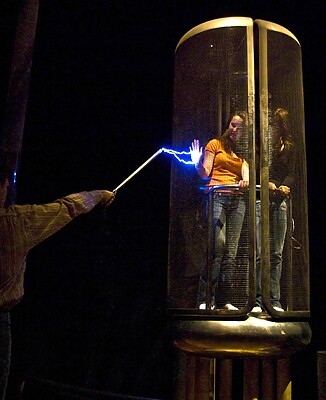The WaveWall Blog
Faraday Cages: What are they? And How Do They Block EMF?
A Faraday cage, named after scientist Michael Faraday, is a type of enclosure created to protect its contents from electromagnetic fields.
Faraday cages are used in various applications to protect electronics, medical equipment, and other sensitive items from interference caused by external electromagnetic fields.
They are also used to protect people from electromagnetic radiation effects, such as cell phones and other wireless devices.
So what are Faraday Cages, and how do they work?
Table of Contents
Who is Michael Faraday?
Michael Faraday (22 September 1791 to 25 August 1867) was an English scientist who made many important contributions to the study of electromagnetism. He is best known for his discoveries of electromagnetic induction, diamagnetism, and the laws of electrolysis.
Faraday also studied the optical properties of light and investigated the relationship between magnetism and electricity. As a result, he was a key figure in the development of modern electrical technology.
One of Faraday’s notable achievements in the field of electromagnetism was his experiment involving a metal-coated room, which he conducted in 1831. Through this experiment, Faraday discovered that a changing magnetic field could produce an electric field.
To demonstrate this, he used two insulated coils of wire wrapped around an iron ring and passed an electric current through one of the coils. This resulted in a momentary current being induced in the other coil.
Additionally, when Faraday moved a magnet through a loop of wire, it caused an electric current to flow in the wire. This experiment led to the formulation of Faraday’s Law, which states that a voltage can be produced across a conductor that is placed in a changing magnetic field or moving through a stationary magnetic field. This process, known as electromagnetic induction, can also induce an electrical current.
Electromagnetism and electromagnetic fields are everywhere in our highly-technologically developed world.
What Are Faraday Cages?
Faraday cages are made from a conductive material, such as metal or mesh, designed to block or reduce the amount of electromagnetic energy that can pass through it. The conductive material is usually arranged in a mesh pattern, which allows the metal to create a shield around the objects or people inside the cage.

This shield prevents electromagnetic fields from passing through and interacting with the items or people contained within the Faraday cage.
The effectiveness of a Faraday cage depends on its construction. For the cage to be effective, it must be made from a continuous piece of conductive material, such as metal or mesh, and the seams or joints must be soldered or welded shut.
If there are gaps or openings in the Faraday cage, it will not effectively block electromagnetic fields.
How Do Faraday Cages Work?
The Faraday cage redirects electric fields and prevents them from entering the cage.
It does this by providing a conductive outer shell which creates a strong electric field around its interior. This electric field reflects incoming electric fields, preventing them from entering the cage. The electric field also absorbs some of the energy from the electric field, dissipating it as heat, though this is negligible in most cases.
In addition to blocking out electromagnetic fields, Faraday cages can also be used to reduce the amount of interference caused by external sources. This can be particularly useful in areas exposed to high electromagnetic interference, such as near airports or power plants.
Faraday cages are also commonly used in laboratories to protect sensitive equipment from interference. Overall, Faraday cages are a simple yet effective way of shielding objects or people from the effects of electromagnetic fields.
There are Different Types of Faraday Cages
There are various types of Faraday cages that can block or attenuate different frequencies of electromagnetic radiation (EMR). The type of conductive material used, the dimensions of the material, and the size of the holes in the material all affect the cage’s ability to block different frequencies of EMR.
The material’s conductivity is also important, with metals such as gold, silver, and copper having high conductivity and the ability to block EMR. However, some materials, such as steel and lead, do not block EMR effectively. The size of the holes in the cage also plays a role in its ability to block EMR, with smaller holes being more effective at blocking shorter wavelengths. While Faraday cages made of the right materials can effectively block radiation, they can also block the fields needed for electronic devices to function.
Finally, although perfect Faraday cages made of the right materials can effectively block radiation, they also block the fields required for devices to function. As an alternative, two-dimensional shields can be used to block radiation from a single direction. These shields must be made of materials that can block the specific frequencies of electromagnetic radiation emitted by technology.
Faraday Cage Use Cases
There are many examples of Faraday Cages in day-to-day life. Some are purposefully designed, e.g. to protect sensitive electronics from interference, whereas others are somewhat ‘accidental’. For example, aeroplanes use the principles of Faraday Cages to protect both people and components from lightning.
Airplanes and Cars
There are many real-life applications of Faraday cages and shields. For example, as mentioned, cars and aeroplanes are both essentially giant metal cages that protect their occupants from lightning strikes using the principles of Faraday cages.

When lightning strikes a car or aeroplane, the electric charges on the surface of the metal conductor are redistributed, causing the electric field inside the cage to be cancelled out. This prevents lightning from entering the vehicle and protects the occupants inside.
Elevators
Elevators also have a Faraday cage effect, which can disrupt the operation of devices that rely on external electromagnetic signals. This is because the metal walls of the elevator block or redirect these signals. As a result, it is common for devices such as cellphones and two-way radios to lose signal strength or connectivity when inside an elevator.
Microwaves
Microwave ovens are also designed as Faraday cages to contain the microwaves used to cook food. The metal walls of the oven block the microwaves from escaping and protect the user from exposure to these waves.
MRI Rooms
MRI rooms are equipped with Faraday cages to prevent interference with the imaging process.
The Faraday cage helps to block external sources of radio frequency interference that could disrupt the imaging process. It also helps to protect people outside the MRI room from exposure to excess radiation.
Infrastructure
Military and government buildings, such as war rooms and data centres, may be designed as Faraday cages to protect against hacking, sabotage, and other forms of electronic attack. The metal walls of these structures block or redirect electromagnetic signals, making it more difficult for electronic attacks to succeed.
These buildings may also be designed to provide some level of protection against electromagnetic pulse (EMP) attacks, which are high-intensity bursts of electromagnetic energy that can disrupt or damage electronic systems.
There are also products on the market that claim to provide EMF radiation protection through the use of conductive shielding materials. These products may include cases for electronic devices, clothing, and other items that are designed to block or redirect EMF radiation.
Electrical Equipment
Screens or shields on cables, such as USB cables or coaxial cables used for cable television, protect internal wiring from external electrical noise and prevent the emission of RF (radio frequency) signals.
In musical instruments, such as electric guitars, Faraday cages made of copper or aluminium foil are used to protect electronic components, like electromagnetic pickups, from interference caused by speakers, amplifiers, stage lights, and other musical equipment. These Faraday cages help to ensure that the instrument functions correctly and produces the desired sound.
Faraday Cages to Protect From EMF
All electronic devices emit EMF radiation to varying extents. However, under normal operation, the EMF emitted by devices falls in the “non-ionizing” category, which means it is NOT the same type of radiation as extremely damaging X-rays, gamma rays, etc.
However, a burgeoning body of research is highlighting how ‘harmless’ EMF emitted by phones, laptops and other devices does have a cumulative impact on the body.
In the past, non-ionizing radiation, such as EMF (electromagnetic field) radiation, was considered largely harmless. However, it is now understood that although it is less harmful than ionising radiation, it is not completely safe, and the potential negative effects of EMF radiation are becoming more apparent.
As our world becomes more electronic, we are exposed to technology that is also often left on constantly. Further, modern electronic devices are also much more powerful and have bigger batteries.
This means that electronic devices today are:
- A) More prevalent
- B) Always on
- C) More powerful
This has changed the way we view the risks associated with electronic devices. In the 1990s, research on the effects of EMF focused mainly on high-powered electronic devices in industrial environments and overhead power lines, where people were exposed to them for extended periods.
Some studies, including those discussed by the World Health Organization (WHO), found a link between EMF exposure and the development of certain cancers. However, given the widespread use of electronic devices and the changed habits of technology use, the focus of research has shifted towards public health concerns.
In recent years, there has been a rapid increase in research on the potential dangers of electronics, especially mobile phones. In 2019, over 250 scientists from various fields, including biology, oncology, public health, and engineering, signed a joint petition calling on governments worldwide to examine the potentially harmful effects of EMF radiation. The WHO has also graded mobile phone radiation as a 2b ‘possible carcinogen’.
There has been a huge range of studies into the harmful effects of phone radiation, and it’s becoming near-impossible to ignore the impacts. In fact, phone companies even recommend users hold their devices away from their bodies to prevent too much radiation from leaking into them!
How Faraday Cages can Protect You
Anti-radiation phone cases like WaveWall work use Faraday cages to block electromagnetic radiation. WaveWall products are independently tested and verified to block 85% of EMF without affecting phone functionality.
By protecting your body with Faraday Cage-equipped technology like phone cases, you can cut your exposure to harmful phone radiation. It’s a relatively simple concept but an effective one for protecting your health from radiation.


